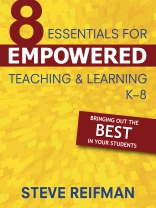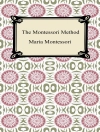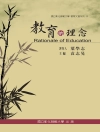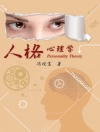‘Contains information that is vitally important for the success of any classroom.’
—Julie Duford, Fifth-Grade Teacher
Polson Middle School, MT
‘Gives teachers a format that we can develop into a philosophy or goal for our classrooms so our students become enthusiastic about learning.’
—Debbie Halcomb, Fourth-Grade Teacher
Robert W. Combs Elementary, Cornettsville, KY
‘Takes Gardner, Covey, Tomlinson, and wraps them all together in a very motivating approach.’
—Karen Kersey, Second-Grade Teacher
Albans Elementary, St. Albans, WV
Embrace quality as the number one priority in your classroom!
Inspirational and practical, this book focuses on the quality of teaching and learning in elementary and middle school classrooms and helps teachers and students find more joy, satisfaction, and meaning in their work.
Experienced teacher Steve Reifman defines a quality classroom in reader-friendly terms, explains how to measure quality, and covers the conditions under which all students are empowered to reach their full potential. The author synthesizes key concepts from the fields of education, psychology, management, and personal growth to arrive at the eight essential elements of teaching, including realistic goal setting, assessment-oriented instruction, parent involvement, and teacher leadership. Written in a personal, engaging voice and drawing upon the work of experts such as Stephen Covey, Howard Gardner, Ted Sizer, William Glasser, Carol Ann Tomlinson, Alfie Kohn, and Alan Blankstein, this resource
- Promotes student motivation and a classroom environment of trust and respect
- Builds higher-level thinking and group problem solving into the curriculum
- Presents classroom applications, examples, anecdotes, and reproducible pages
- Features ideas from practicing teachers for putting these essential ideas to work in the classroom
Eight Essentials for Empowered Teaching and Learning, K–8 motivates student teachers, beginning teachers, and veteran educators to become the most effective instructors they can be and achieve the best learning outcomes possible for their students.
Daftar Isi
List of Figures
Acknowledgments
About the Author
Introduction
1. Essential 1: Establishing a Sense of Purpose
The Overall Aim
Class Mission Statement
The Seven Life Roles
Personal Mission Statements
Key Points From Essential 1
2. Essential 2: Determining Goals
What Is Quality?
Determining Student Goals
Key Points From Essential 2
Reflection Questions
3. Essential 3: Building Quality Into the Process
The Inspection Role Play
The Writing Process Example
Guiding Approaches
Disciplinary Understanding
The Funds of Knowledge Approach
Differentiated Instruction
Multiple Intelligences
Wrapping Up the Story Writing Example
Building Quality Into the Process: Other Examples
The Yearlong Perspective
A Single School Day
Individual Lessons
Key Points From Essential 3
Reflection Questions
4. Essential 4: Involving Parents
Nine Reasons to Make the Effort
Guiding Principles for Home-School Communication
Ways to Build and Maintain Relationships With Parents
Other Ways to Promote Working Together
Helping Parents Help Their Children
Back to School Night, Conferences, and Open House
Key Points From Essential 4
Reflection Questions
5. Essential 5: Improving Continuously
Improving Our Habits of Character
Academic Improvement at the Individual Level
Academic Improvement at the Team Level
Increasing Enthusiasm Throughout the Year
Continuous Process Improvement: The Personal Spelling List Example
Individual Improvement Projects
Our Development as Professional Educators
Key Points From Essential 5
Reflection Questions
6. Essential 6: Investing in Training
Key Points From Essential 6
Reflection Questions
7. Essential 7: Nurturing Intrinsic Motivation
Classroom Parallels
The Problems With Rewards
Coming to Grips With These Findings
A Different Approach
Nurturing Forces of Intrinsic Motivation
Intrinsic Motivation: A Summary
Key Points From Essential 7
Reflection Questions
8. Essential 8: Exercising Leadership
The Big Picture
Rounding Out the Leadership Skeleton
Conclusion
Key Points From Essential 8
Reflection Questions
Resource A: The Seven Life Roles
Resource B: Guiding Approaches
Resource C: Classroom Management Plan
Resource D: Using Student Handbooks
Notes
References
Index
Tentang Penulis
Steve Reifman has been an elementary school teacher for more than 13 years. During that time, he has earned National Board Certification, traveled to Japan as a Fulbright Memorial Fund Scholar, and completed two master’s degrees. He has experience working with students in all of the elementary grades, and he has taught in both public and private schools. Currently, Reifman teaches third grade at Roosevelt Elementary School in Santa Monica, California.Ever since reading William Glasser’s The Quality School at the beginning of his career, his primary interest has been in the field of quality control. Reifman has read extensively in this area, has created and led numerous professional development courses, and has attended many conferences and workshops. Specifically, the focus of his work in the classroom has involved defining quality in student-friendly terms, measuring it, and creating the conditions where all students are empowered to reach their full potential and appreciate the joy of learning.












